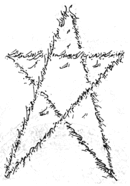Mullá Husayn
| Part of a series on |
| Bábism |
|---|
 |
| Central figures |
| Key scripture |
| Institutions |
|
| History |
| Divisions |
| Other topics |
|
Mullá Husayn (1813–1849) (Persian: ملا حسين بشروئي Mullah Hossein Boshru'i), titled Jináb-i Bábu'l-Báb ("Gate of the Gate"), was a Persian religious figure and the first Letter of the Living of the Bábí movement. He died at the Battle of Fort Shaykh Tabarsi, on February 2, 1849. The title of Bábu'l-Báb was bestowed upon him by the Báb.[1]
-

The Báb's tablet to Mullá Husayn, the first Letter of the Living -

Some of the writings of the Báb in the handwriting of Mullá Husayn
Background
Mohammad Hossein Boshru'i was born in Boshruyeh in South Khorasan to a wealthy and established family of the town.[2] His father Hajji Mullah Abdullah was a dyer; his mother was a poet and known for her piety and knowledge.[2] Like most young boys of the era he received a haphazard education, learning a little scripture, reading, writing and basic mathematics.[2] At the age of 12 he left school and pursued higher education, which included lessons in Persian literature and the Qur'an, whilst mastering the art of debate.[2] By 21, he was already a mujtahid and whilst studying in Mashhad he became attracted to the teachings of Shaykh Ahmad and Shaykhism.[2]
Declaration of the Báb
According to Mullah Husayn, the Shaykhi leader Sayyid Kazim Rashti, instructed his followers to spread out in search of the Qa'im.[3] On Sayyid Kazim's death, Mulla Husayn spent forty days secluded in prayer, after which he traveled to Bushehr and then to Shiraz.[4] There, on 22 May 1844, he encountered the Báb, who declared to Mulla Husayn that he was the expected Qa'im.[5][6] Mulla Husayn thus became the first of the Báb's followers.[6] The anniversary of this declaration is observed as a holy day by Bahá'í communities around the world.
Notes
- ↑ Zarandi, Nabil; translation by Shoghi Effendi (1996). The Dawn-breakers (Reprint ed.). Wilmette, Illinois: Bahá'í Publishing Trust. p. 63. ISBN 0-87743-020-9.
- 1 2 3 4 5 Mehrabkhani 1987
- ↑ Zarandi (1932). The Dawn-Breakers. p. 57.
- ↑ Sears, William (1960). Release the Sun. Wilmette, Illinois: Bahá'í Publishing Trust. pp. 9–11. ISBN 0-87743-003-9.
- ↑ Encyclopædia Britannica. "the Bāb". Retrieved 2009-11-10.
- 1 2 Effendi, Shoghi (1974). God Passes By. Wilmette, Illinois 60091: Bahá'í Publishing Trust. p. 5. ISBN 0-87743-034-9.
References
- Amanat, Abbas (1989). Resurrection and Renewal. Cornell University Press, New York, USA. ISBN 0-8014-2098-9.
- Mehrabkhani, Ruhu'llah (1987). Mulla Husayn: Disciple at Dawn. Los Angeles: Kalimát Press. ISBN 0-933770-37-5.
- Nabíl-i-Zarandí (1932). Shoghi Effendi (Translator), ed. The Dawn-Breakers: Nabíl’s Narrative (Hardcover ed.). Wilmette, Illinois, USA: Bahá'í Publishing Trust. ISBN 0-900125-22-5.
- Smith, Peter (1999). A Concise Encyclopedia of the Bahá'í Faith. Oxford, UK: Oneworld Publications. ISBN 1-85168-184-1.
External links
| Wikimedia Commons has media related to Mullá Husayn. |
- Glossary of the Kitáb-i-Íqán - includes a small biography of Mullá Husayn
- Religious Systems of the World: A Contribution to the Study of Comparative Religion (London: Swann Sonnenschein), "The Bab", by Browne, E.G,pp. 335.
- Mullá Husayn, by Lowell Johnson